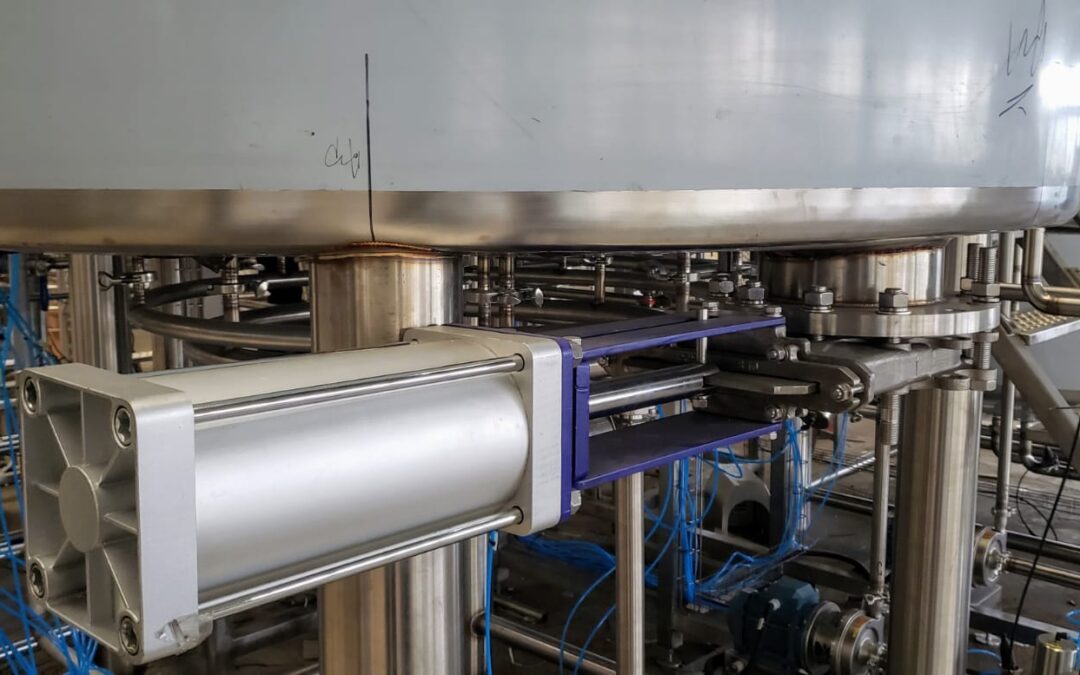Brewing production is the process of creating beer from raw ingredients through a series of complex steps that transform the ingredients into a finished beverage. The brewing process typically involves several stages, including mashing, boiling, fermentation, and packaging.
Here’s a brief overview of each brewing stage:
- Mashing: During this stage, the malted barley is mixed with hot water to create a mash. Enzymes present in the malted barley convert the starches in the grain into sugars, creating a sweet liquid known as wort.
- Boiling: Once the mash has been created, it is transferred to a kettle where it is boiled with hops. This stage serves to sterilize the wort and to add bitterness, aroma, and flavor to the beer. The hops are added at different times during the boil to create different flavor profiles.
- Fermentation: After the wort has been boiled, it is cooled and transferred to a fermentation vessel, where yeast is added. The yeast converts the sugars in the wort into alcohol and carbon dioxide, creating the beer’s unique flavors and aromas.
- Packaging: Once the beer has fermented, it is transferred to a bright tank where it is carbonated and conditioned. From there, it is packaged into bottles, cans, or kegs and sent to distributors or directly to customers.
Brewing production can vary depending on the specific beer style and the brewery’s processes and equipment. Some breweries may use additional ingredients, such as fruit or spices, or employ different brewing methods, such as barrel-aging or souring. However, the basic stages of mashing, boiling, fermentation, and packaging remain consistent.
Increasing Craft Beer Brewery Production:
Increasing brewing production requires careful planning, efficient processes, and investment in equipment and personnel. Here are some best ways to increase brewing production:
- Streamline your brewing process: Identify areas in your brewing process that can be made more efficient. Automating or simplifying certain steps, reducing downtime, and eliminating bottlenecks can help increase production capacity.
- Invest in equipment and infrastructure: Upgrading equipment, expanding your brewery’s physical space, and optimizing your layout can help you increase your brewing capacity. Investing in larger fermentation tanks, canning and bottling lines, and efficient cooling and heating systems can help you produce more beer.
- Hire additional staff: Adding more personnel can help you increase production capacity by enabling you to operate multiple shifts or expand your brewing operations.
- Improve supply chain management: Managing your raw material and supply chain efficiency can help you reduce costs and avoid delays in production. Establishing relationships with reliable suppliers, negotiating favorable pricing, and monitoring inventory levels can help ensure you have the materials you need to brew beer on time.
- Monitor your brewery’s performance: Regularly monitoring your brewery’s performance can help you identify inefficiencies, optimize processes, and reduce downtime. Analyzing your brewery data and production metrics can help you make data-driven decisions that improve efficiency and boost production.
Overall, increasing brewing production requires a multi-faceted approach that involves optimizing processes, investing in infrastructure and personnel, managing your supply chain efficiently, and monitoring performance regularly.
Doubling Craft Beer Brewery Production Fast Hacks:
Doubling your craft beer brewing production requires careful planning and execution to ensure that you can maintain the quality of your beer while increasing your output. Here are some steps you can take to double your craft beer brewing production:
- Analyze your current brewing process: Start by analyzing your current brewing process to identify areas that can be improved. Look for inefficiencies, bottlenecks, and areas where you can optimize your process. You may need to make changes to your equipment, recipes, or workflows to increase your production capacity.
- Invest in additional equipment: Increasing your brewing production will likely require investing in additional equipment. Consider purchasing larger fermenters, more kegs or barrels, or a canning or bottling line. Upgrading your heating, cooling, and filtration systems can also help you scale up production.
- Expand your brewing space: If your current brewing space is limiting your production capacity, you may need to consider expanding your facility. This could involve building an addition or moving to a larger facility altogether. Be sure to factor in the costs and time required for any construction or relocation when planning for increased production.
- Hire additional staff: Doubling your production may require additional personnel to manage the increased workload. Consider hiring additional brewers, packaging staff, or administrative personnel to help manage the additional demand.
- Develop a production plan: Once you have identified the changes required to double your brewing production, develop a production plan that outlines the new processes, workflows, and timelines. Be sure to communicate the plan to all stakeholders, including employees, suppliers, and distributors.
- Test and adjust your process: As you begin to increase your brewing production, monitor the quality of your beer closely. Test and adjust your process as necessary to ensure that the quality of your beer is consistent with your current product.
Increasing your craft beer brewing production can be challenging, but with careful planning and execution, you can achieve your production goals while maintaining the quality and integrity of your beer.
Ultimate Brewing Production Fast Hack: Utilizing A Hydraulic Knife
A hydraulic knife is a mechanical tool that uses hydraulic pressure to move a blade and helps save time and money during craft beer creation. In the brewing process, a hydraulic knife can be used at the bottom of a mash tun in conjunction with a Norad mixer to rapidly remove spent grain into a container or crate allowing a prompt hot water rinse followed by the next grain bill-cutting labor time and doubling production.
During the brewing process, hot water is added to a mixture of grains in the mash tun to extract sugars from the grain. This mixture, known as “wort,” is then separated from the spent grain, which is no longer useful for brewing.
To remove the spent grain from the mash tun, a hydraulic knife is used to move a blade along the bottom of the tun. This blade cuts through the spent grain, which is then pushed toward an outlet in the tun. The hydraulic pressure provides the force needed to move the blade and the spent grain quickly and efficiently, allowing for faster and more complete removal of the spent grain while also improving microbiology and avoiding contamination due to the efficacy hydraulic knife which can save up to as much as an hour CPing per brew.
Once the spent grain is removed, it can be repurposed as animal feed or composted, while the wort is used in the next steps of the brewing process to create beer. Another benefit of this brewing tool is the fact that you can save time and money via efficiency by mutualizing double batch fermenters for popular craft beer or introducing a fruit base to the second batch making it a summer sipper is known as a Radler.
What Is A Radler?
A Radler, also known as a shandy, is a mixed drink that is typically made by combining beer with a non-alcoholic beverage, most commonly lemonade or citrus soda. The term “Radler” is derived from the German word for “cyclist,” as the drink was originally created as a refreshing and low-alcohol option for cyclists who wanted to enjoy a drink without getting too drunk.
Radlers are usually made by mixing beer with a 50/50 ratio of the non-alcoholic beverage, though the ratio can vary depending on personal taste. The resulting drink is light and refreshing, with a lower alcohol content than a typical beer. Radlers are often served over ice and are popular in the summer months as a refreshing drink for outdoor events and activities.
In addition to lemonade and citrus soda, other non-alcoholic beverages can be used to make a Radler, such as grapefruit juice, ginger beer, or even iced tea. Some breweries also produce pre-made Radlers that can be purchased in cans or bottles.
To finish up the use of a hydraulic knife in this process helps to save time, and money and increase the efficiency of the brewing process. When you implement the use of a hydraulic knife in your brewing processes with the help of expert craft beer equipment consulting you can be well on your way to increasing your beer-making production and efficiency in no time.

